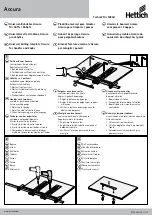
11
Tighten the screws enough to ensure a tight fit
between casting and sheet metal parts.
(It may be necessary to re-drill 1/8” pilot holes for
the self-tapping screws due to misalignment caused
by shifting tolerances with the cast iron arch.)
Note: The weight of the cast plate must not be
carried by the connection to the heater. It must
rest on a hearth.
12. Remove the window
and set it aside.
13. Pull the plumbers straps inward, tight,
drawing
the engine inward and pulling the outer cast arch
tight against the wall finish.
Screw the straps to the inner side of the side mount
flange to ensure the outer cast arch remains flush
against the wall. You may need to drill a pilot hole.
Repeat on other side.
14. Replace the window.
Flush
15. Hang the Inner Cast Arch
. Insert the mounting
hooks into the notches in the outer cast plate.
The fit or gap between the inner cast arch and the
outer cast plate may be tightened by bending the
mounting hooks slightly inwards.
Do not bend the hooks too far or the inner arch
will be difficult to remove!
If this happens, a
screwdriver inserted through the gap between the
back of the inner arch and the heater should be
able to pry the hook away from the backing plate.
Do not hit the hooks with a hammer as this may
break the welds holding them.
16. Slide the hearth fender up to the front of the
casting.
Note: It is important that the hearth in front of
heater be flush with the bottom of the heater;
otherwise the hearth fender will not rest at the
proper height.












































